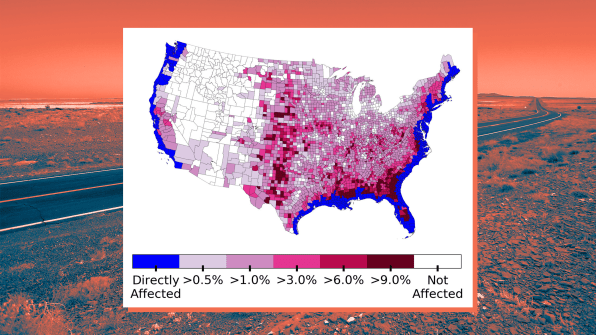This map shows where people on the coasts will flee to once sea levels rise
Sea-level rise in the U.S. won’t only affect people living on the coasts—as homes flood in Florida and New Jersey, it may trigger mass migration inland, potentially making housing more expensive and jobs harder to find in other areas. A new study uses AI to map where people may go.
“We realized that while existing research has studied the effects of sea-level rise on coastal populations, it hasn’t considered the farther-reaching effects,” says lead author Caleb Robinson, a doctoral scholar at Georgia Tech who is currently doing research at USC. “In our study, we really aim to get at the indirect effects that sea-level rise can have through migration.”
Around 13 million Americans could be forced to move by the end of the century if the sea level rises six feet, headed in large numbers to the Midwest and cities like Atlanta, Houston, and Dallas. The study looked at projections for sea-level rise and population growth, and then trained a machine-learning model using data about where people moved after Hurricane Katrina and Hurricane Rita. While another previous study did also predict climate migration, it was based partly on how people move under normal circumstances. The new work is designed to come closer to what happens when people are fleeing the effects of climate change. “We really believe that dynamics when it’s forced migration, versus business as usual migration, will be different,” says Bistra Dilkina, a computer science professor at USC and one of the authors of the paper.

Of course, this only accounts for one impact from climate change. People may also move (and in different patterns) because of wildfires, long-term droughts, and other climate disasters. And they may overlap: Houston, one of the cities that the map suggests may see a large influx of climate migrants, saw more than 200,000 homes damaged from the flooding caused by Hurricane Harvey, a storm that saw record rainfall because of the changing climate. The framework created in the study, however, could also be used to look at where other types of disasters may force people to move. “It will basically be a matter of whether we have enough data to be able to say we have a good estimate of how people behave in these situations,” says Dilkina. “As we have seen, natural disasters are increasing in number and severity, and I think we will be getting more and more data, unfortunately.”
Cities that expect to see more climate migrants can use this type of research to begin to think about how to prepare for a growing population—something that few are doing now, although the mayor of Buffalo, New York, called it a “climate refuge” city in his state of the union address last year, and the local government thinks that potential migrants could help revive the city. Other cities may need to think about changes in infrastructure or housing.
Over time, as data improves, new maps can be created to help urban planners continue to prepare. “That’s why we made a big effort to actually make all our code open-source and everything available, so that as new data is collected, the new better models are being developed, it’s easy to rerun the same simulation and studies and projections,” Dilkina says.
(16)



